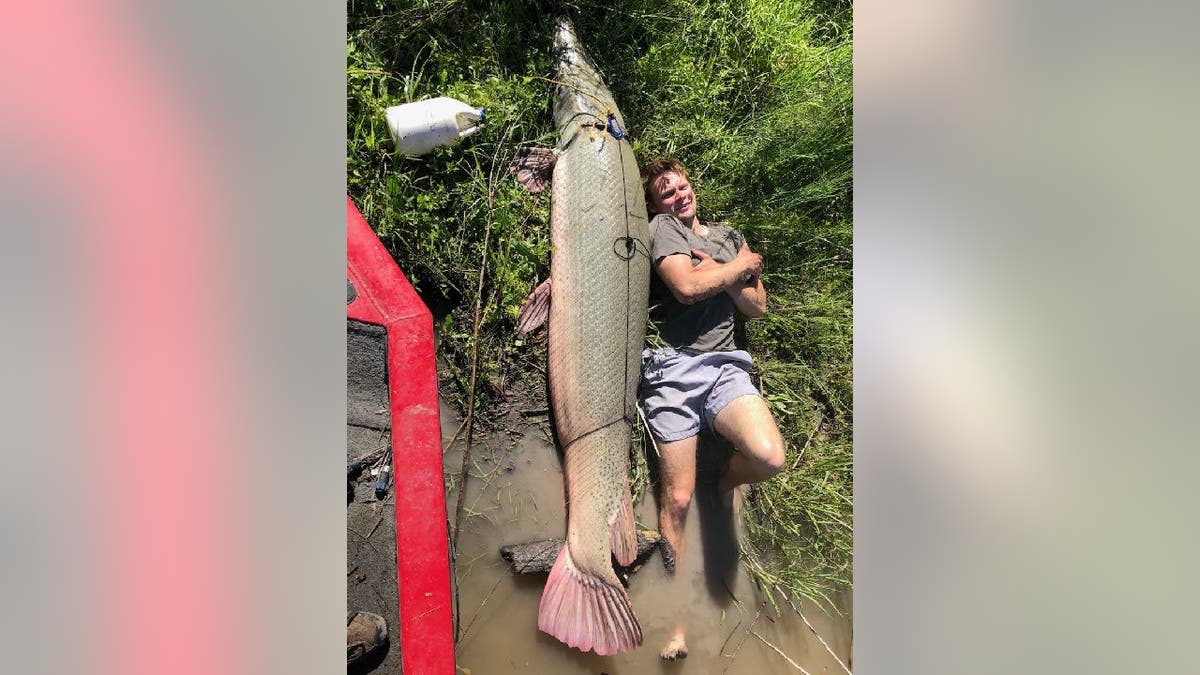Fox News Flash top headlines for May 25
Fox News Flash top headlines are here. Check out what's clicking on Foxnews.com.
A man from Texas has been recognized for catching the heaviest alligator gar on record from Lake Corpus Christi.
Paul Hefner, a Texas angler, used a jug line to capture a 207-pound alligator gar in mid-April, and his record-breaking catch was finally recognized by the Texas Parks and Wildlife Department on Tuesday, May 23.
The wildlife agency revealed Hefner’s catch to the public with photo-inclusive Twitter and Facebook posts that show the massive fish was longer than its catcher’s body.
ALABAMA FATHER AND SON CATCH RECORD-BREAKING, 162-POUND ALLIGATOR GAR
"Move over, Rover. This 207 lb alligator gar set a new record for Lake Corpus Christi before being released back to swim another day," the Texas Parks and Wildlife wrote in both posts.

Paul Hefner of Texas caught a 7.5-foot alligator gar from Lake Corpus Christi, which broke the local fishing record for alligator gar. (Paul Hefner)
The alligator gar was caught on April 13 and reportedly measures 90 inches in length, according to the wildlife department’s "All-Tackle Records for Lake Corpus Christi" webpage.
At the start of May, the Texas Parks and Wildlife Department issued a news release that shared "best practices" for catching and releasing alligator gar in the state.
Texas Parks and Wildlife officials recommend three practices to ensure the safety of alligator gar.
1. Use non-stainless-steel tackle and don’t use hooks larger than 3/0
The Texas Parks and Wildlife recommends stainless steel lines and leaders because these fishing accessories don’t degrade as quickly. Bronze fishing gear reportedly degrades quicker, but in some cases, bronze hooks can be beneficial (as outlined in best practice no. 3).
VIRGINIA FISHERMAN REELS IN RARE LARGEMOUTH BASS FROM RIVER: 'HAVEN'T SEEN ANYTHING LIKE THAT'

The Texas Parks and Wildlife reports that alligator gar are species that's "as old as the dinosaurs" and lives in rivers, reservoirs and estuaries throughout the state. (Texas Parks and Wildlife)
Using fishing hooks that are larger than 3/0 could result in damaging the internal organs of an alligator gar or small fish, according to the wildlife agency.
2. Catch alligator gar and similar large fish from shore rather than boat
Catching an alligator gar or another large fish species from shore is less likely to cause injuries to fish, according to Texas Parks and Wildlife.
"The use of lassos or snares to lift a fish over a boat gunnel may result in internal injury to a heavy fish like alligator gar," the wildlife agency wrote. "If possible, keep the fish in or near the water; fully support the weight of the fish when taking photos before release. Minimize handling time."
3. Cut the lined or leader on "deeply hooked" alligator gar and similar fish
The Texas Parks and Wildlife notes that scientific studies have found that caught fish have a higher survival rate when anglers cut their fishing lines or leaders.
"Hooks lodged beyond the mouth cavity (in the throat, gullet or stomach) should not be removed — most studies suggest additional damage is often caused by attempting to remove a deep hook," the Texas Parks and Wildlife wrote.
RECORD-BREAKING FISH: HUGE CATCHES THAT MADE HEADLINES IN 2022
The wildlife agency added that using non-stainless steel hooks on alligator gar can be helpful to the fish’s survival because the metal will "degrade relatively quickly and can be more easily shed by a gar."

The Texas Parks and Wildlife says it's safer to fish alligator gar from shore if an angler is hoping to release the fish after their catch. Doing so reportedly minimizes the chance of injury on the fish. (iStock)
Biologists with the Texas Parks and Wildlife Department have reportedly seen catch-and-release alligator gar grow to weigh more than 300 pounds and measure up to eight feet in length.
"Catch-and-release fishing for alligator gar has become quite popular and data from a current evaluation in progress indicates high survival rates for released fish," Dan Daugherty, an inland fisheries senior scientist at the Texas Parks and Wildlife Department, said in a statement.
CLICK HERE TO SIGN UP FOR OUR LIFESTYLE NEWSLETTER
"We’ve even recorded some fish being caught and released three or four times over multiple years," he continued.
Anglers who wish to submit their catch-and-release fish for record consideration need to review the Texas Parks and Wildlife’s program rules, be able to locate and use certified scales, have a measuring tape, take several photos and fill out an Angler Recognition Award application.
The certification process can take between six and eight weeks, according to the Texas Parks and Wildlife Department.
CLICK HERE TO GET THE FOX NEWS APP
The largest alligator gar caught in Texas happened in 1953 with a trot line. The state-record fish reportedly weighed 302 pounds, according to the wildlife agency's current statewide record list.


